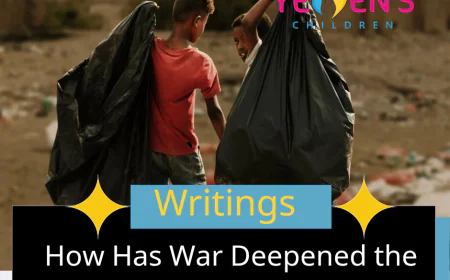Our displaced children
According to the Humanitarian Response Report for 2023, prepared by the United Nations Office for the Coordination of Humanitarian Affairs (OCHA), the number of displaced people in Yemen - currently - is estimated at 4.5 million people (i.e. 14% of the country’s population), most of whom have been displaced several times over several years. The continuation of prolonged displacement - even with declining rates of new displacement - will ensure that Yemen remains among the six largest cases of internal displacement in the world.
Marib Governorate is the Republic's governorate that receives the most displaced people and is the most crowded, as it currently includes more than 200 camps and displacement gatherings, in addition to the displaced people who are renting in the city and living in homes.
The situation of the displaced varies throughout Yemen, except that the humanitarian and living conditions are extremely difficult and complex, especially for children. Camps constitute a living environment that exposes children to many risks and challenges that negatively affect their lives and their psychological and physical well-being.
With these harsh conditions that most displaced families live in, including hunger, deprivation, and poverty, children become more vulnerable to early labor, exploitation, and multiple dangers.
In addition to what they are already experiencing, deprivation of most rights, most notably education, as a result of the lack of schools, teachers, and curricula, as well as health and social care services.
In addition to the direct risks, including fire incidents, hundreds of which were recorded in camps for the displaced, especially in Marib, and most of their victims were children. In addition to this, there are risks of traffic accidents, drowning in flood drains, sewage pits, etc.
In any case, they remain the most affected by displacement and the humanitarian crisis. In the summer, they are the most affected by rain, torrents, and floods, and in the winter, they are the easiest prey to frost. The year 2023 and before recorded the death of many children in displacement camps due to extreme cold, especially newborns. Most of the housing consists of dilapidated cotton tents that do not protect family members from the heat of summer or the cold of winter.
All of this calls for more attention from official authorities, UN organizations, and international agencies to find specific interventions to improve the life and living conditions of children, and to strengthen local capabilities to deal with the magnitude of children’s special needs, the most prominent of which is providing schools and equipping them with equipment, curricula, and teachers to accommodate thousands of children deprived of education, and motivating them to enroll. In schools, in addition to providing appropriate health care services for children. As well as providing more outlets for children to overcome the traumas of war and the damage of displacement and deprivation.
Recently, we have noticed a trend on the part of the government and international agencies to implement more effective and lasting interventions, and here we stress the need to pay attention to projects that will provide job opportunities for families and support them financially to reduce the economic pressures they are experiencing and the exposure of their children to danger. As well as providing safe and child-friendly spaces in displacement camps.
Those you find running in the alleys of displacement camps are not small numbers on the sidelines of life and events, but rather they are our future and the future of this country, and caring for them and improving their conditions now makes this future bright and prosperous.
*Writing specifically for the yemenschildren Platform








